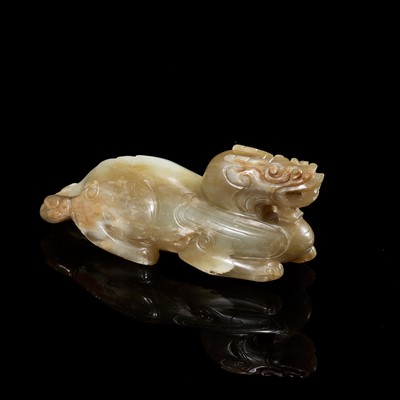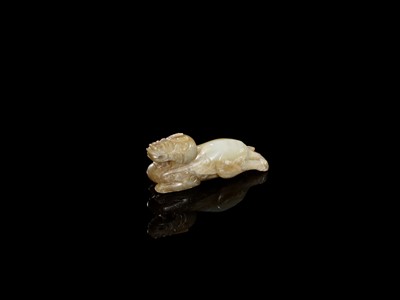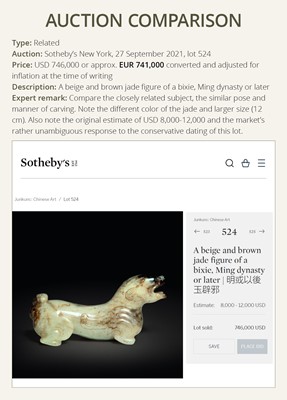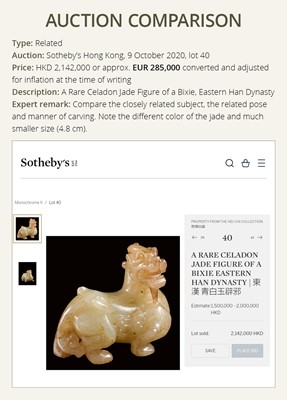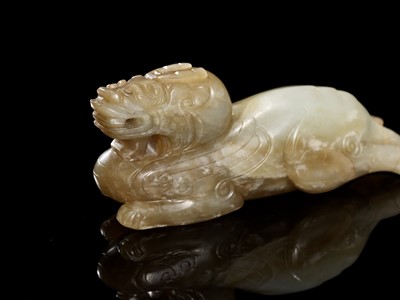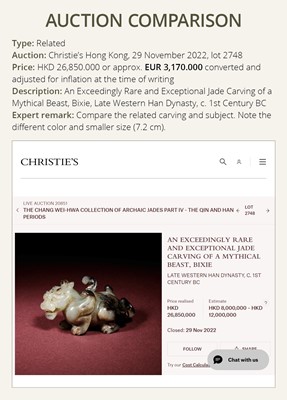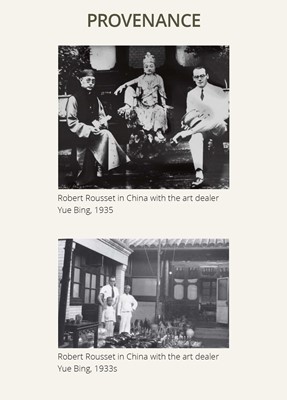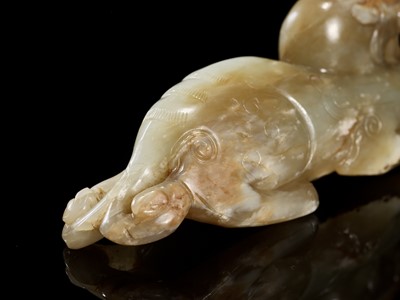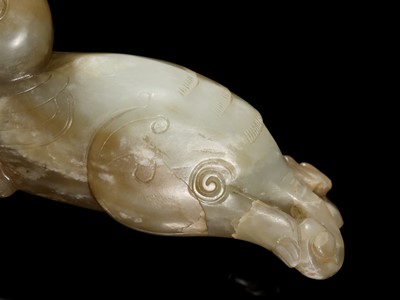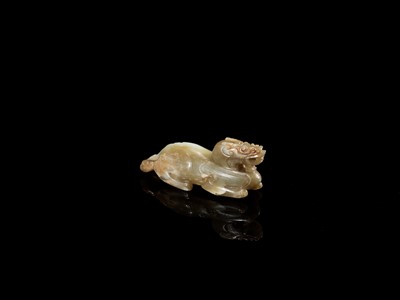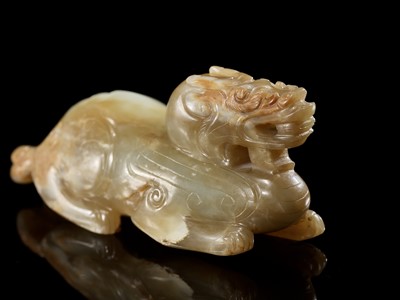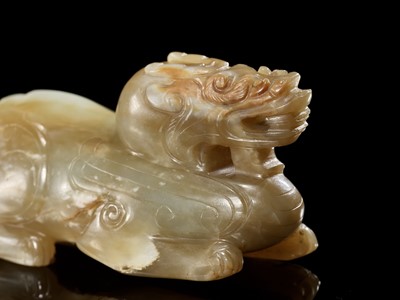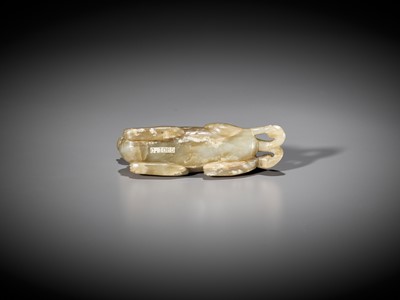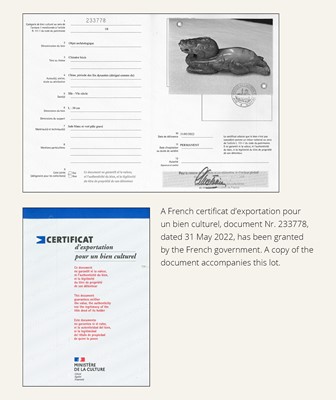9th Mar, 2023 13:00
TWO-DAY AUCTION - Fine Chinese Art / 中國藝術集珍 / Buddhism & Hinduism
34
A RARE, LARGE AND POWERFUL JADE FIGURE OF A BIXIE, MID-WESTERN HAN DYNASTY - EARLY SIX DYNASTIES PERIOD
西漢中期至六朝初期玉雕避邪
Sold for €46,800
including Buyer's Premium
Expert’s note: The magnificent polish and remarkably unctuous feel overall are a distinctive testimony of many centuries of passionate handling, indicating that this piece may either be a rare heirloom example, or at the least was only buried for a rather short period, and thence handed down from generation to generation of respectful keepers.
China, c. 100 BC to 400 AD. Powerfully carved in a prowling pose with the legs and the right haunch tucked under the body and the left extended backward, rigorously pushing the winged body forward. The face with bulging eyes below thick brows and a pair of curved horns, the pierced mouth baring teeth above the distinct goat beard. The body neatly incised with wings, fur markings, and scroll motifs. The softly polished translucent stone is of a pale green and creamy russet-brown tone with distinct chestnut inclusions and russet veining.
Provenance: The personal collection of Robert Rousset, acquired before 1935. Thence by descent to Jean-Pierre Rousset. The underside with an old label, ‘C. 1085’. Robert Rousset was a former French radio officer in the merchant navy, who became one of the most prominent pioneers of the Chinese art market in Paris. As a child, his father, an insurance agent, would take him to Hôtel Drouot where he started to buy at a very young age. His true passion for Asian art started in the 1920s, when he was sent on a mission to Beijing after the decline of the Qing empire, along with Osvald Sirén, the famous Swedish Asian art historian and connoisseur. He then became one of the main contributors of Chinese antiques for the Compagnie de la Chine et des Indes, founded in Paris in the early 20th century by the Blazy brothers. After the 1929 stock market crash, he had the opportunity to acquire the company. With his sister Suzanne in charge of the porcelain, they developed the business and became one of the most important dealers in France, selling pieces to the greatest museums, including the Musée Guimet and the Metropolitan Museum of Art. With no children of his own, Robert took his nephew Jean-Pierre (1936-2021) under his wing and began grooming him to eventually take over the gallery. He loved to wander with Jean-Pierre through the gallery's exhibitions and storerooms, telling stories about each piece while cultivating his protégé’s eye. Jean-Pierre was also sent by his uncle to train with the great expert in Asian art and Robert’s close friend, Michel Beurdeley, whose numerous publications are still commonly referenced today. When Robert passed away, his private collection was divided between Jean-Pierre and his sister, Anne-Marie, whose part was sold with great success after her death in 2019.
Condition: Good condition with minor wear, few tiny nicks and light scratches. A small section of the tail has been reattached. The stone with natural inclusions and fissures, some of which may have developed into small hairline cracks over time.
Export License: A French certificat d’exportation pour un bien culturel, document Nr. 233778, dated 31 May 2022, has been granted by the French government. A copy of the document accompanies this lot.
Weight: 183.4 g
Dimensions: Length 10 cm
Moving away from the highly stylized depictions of animals in the Shang and Zhou dynasties, artisans of the early Western Han Dynasty through to the early Six Dynasties period continuously developed a more naturalistic approach to representing animals. This aesthetic was applied to images of both real and mythical creatures, and across artistic mediums. At the same time, lapidary arts flourished, and jade animals of unprecedentedly high quality started to be carved. The present bixie is a superb example of the sculptural practices of the period, and the era's enthusiasm for miraculous creatures that were believed to possess supernatural power.
Pixiu are mythical hybrid creatures, considered powerful protectors, resembling strong, winged tigers or lions, auspicious for wealth, and said to have a voracious appetite exclusively for gold, silver, and jewels. Therefore, Pixiu have always been regarded as being capable of drawing cai qi (wealth) from all directions, and according to the Chinese zodiac, they are especially helpful for those who are going through a bad year. There are two types of Pixiu: The one with two horns is the female, called Bixie. The one with only one antler is the male, called Tianlu.
Emperor Wu of the Han dynasty declared that the pixiu would be forever known as the ‘Treasure of the Emperor’, that only royal personage could possess a pixiu, and that it was strictly forbidden for all others to own one, including officials. This law was kept through to the very end of the Qing dynasty. Lifelike sculptures of these mythical beings made from durable materials, such as jade, were made to embody and pacify the elemental and supernatural forces of the living world.
Winged beasts in general (lion, tiger, deer, ram, eagle… etc.) are a popular and enduring subject in ancient Chinese works of art, and exist in many different forms (as a decorative pattern, flat carving or carving in the round). The most eye-catching amongst them are carvings of bixie in the round. The term bixie first appeared in Jijiupian by Shi You in the Western Han period: ‘Sheji, bixie are both names of mythical beasts… bixie means ‘warding off the wicked’. It is said that jade pendants in the form of these two beasts can help prevent adversity and provide protection.’
The iconography of the bixie is closely associated with that of the griffin, popular in the Western Asia and Eurasia steppes, and originated in Mesopotamia in 3000 B.C. Bixie occupies a curious position in Chinese art. It is based on the imagery of a lion, a foreign animal, but has the spirit of a fierce tiger. It is often depicted alongside other exotic animals as artistic backdrops for monumental architectures, especially in the Han dynasty where palaces, temples, shrines and tombs were often decorated with large scale bronze or stone sculptures of Weng Zhong, qilin, tianlu, elephants, camels or horses. Bixie is an important component amongst the array that makes up this subject matter.
Jade bixie carvings in the round are extremely rare and precious. There are two jade bixie excavated in the Weiling tomb in Xianyang, Shaanxi province: one is striding upright, with two horns curling backwards along the head (fig. 1), the other is crouching with its head down, with two horns growing closely alongside and bifurcating at the tip (fig. 2). There is an Eastern Han jade bixie (fig. 3) in the Taipei Palace Museum with a long snout resembling either a dragon or a horse, unlike the more common tiger-like bixie with shorter snouts, and closely resembles the griffin of Western Asia.
Amongst the very few excavated and heirloom examples of jade bixie, the two examples from the Weiling tomb are dated the earliest, indicating that the production of these bixie carvings in the round began as early as the mid-Western Han dynasty. Although none of the bixie carvings from the Two Han dynasties appear identical to one another, they share these characteristics: Double or single-horned, with lion or tiger head and body, goat beard and bird wings. They are also extremely fierce, powerful in musculature, gallant in stature, carved in the round and decorated with incised decoration, shallow relief, high relief and pierced decoration in precise and neat wheel cuts.
Although jade bixie have heads like a lion or a tiger, it is the tiger that most embodies its essence. In the Three Kingdoms period, Zhuge Liang in his military strategy coined the now well-known term ‘like a tiger added with wings’ to describe a general that excels at deploying his troops. The origin of this phrase can be found in his anthology Zhuge Zhongwuhou wenji, juan 4, edited by Zhang Shu (1781-1847): “Military command is the mandate to lead the three armies, and the authority of the chief commander. A general who has the command of the army and knows the essence of troop deployment to gain the upper hand, is like a fierce tiger that has been given wings and able to travel the four seas, to apply force when he sees fit.”
Zhuge Liang’s description of an able general as ‘a tiger added with wings’ is the Han dynasty jade bixie personified.
Auction result comparison:
Type: Closely related
Auction: Sotheby’s New York, 21 September 2021, lot 46
Price: USD 107,100 or approx. EUR 107,000 converted and adjusted for inflation at the time of writing
Description: A beige and russet jade bixie, Han - Six Dynasties
Expert remark: Compare the closely related subject, pose, manner of carving, and russet veining. Note the beige color and much smaller size (7 cm).
Auction result comparison:
Type: Related
Auction: Sotheby’s Hong Kong, 9 October 2020, lot 40
Price: HKD 2,142,000 or approx. EUR 285,000 converted and adjusted for inflation at the time of writing
Description: A Rare Celadon Jade Figure of a Bixie, Eastern Han Dynasty
Expert remark: Compare the closely related subject, the related pose and manner of carving. Note the different color of the jade and much smaller size (4.8 cm).
Auction result comparison:
Type: Related
Auction: Sotheby’s New York, 27 September 2021, lot 524
Price: USD 746,000 or approx. EUR 741,000 converted and adjusted for inflation at the time of writing
Description: A beige and brown jade figure of a bixie, Ming dynasty or later
Expert remark: Compare the closely related subject, the similar pose and manner of carving. Note the different color of the jade and larger size (12 cm). Also note the original estimate of USD 8,000-12,000 and the market’s rather unambiguous response to the conservative dating of this lot.
Auction result comparison:
Type: Related
Auction: Christie’s Hong Kong, 29 November 2022, lot 2748
Price: HKD 26,850.000 or approx. EUR 3,170.000 converted and adjusted for inflation at the time of writing
Description: An Exceedingly Rare and Exceptional Jade Carving of a Mythical Beast, Bixie, Late Western Han Dynasty, c. 1st Century BC
Expert remark: Compare the related carving and subject. Note the different color and smaller size (7.2 cm).
西漢中期至六朝初期玉雕避邪
中國,約公元前 100年至公元400年。神獸呈低蹲攻擊姿態,雙腿收在身體下方,作虎行狀;雙目炯炯,張嘴露齒,頭頂有雙角;兩側可見翅膀,尾巴分叉彎曲。玉料呈細膩的淡青和赤褐色調,局部亦有原玉璞中的黃褐色沁。
專家注釋:拋光細膩,玉質瑩潤,表明這件拍品曾作爲傳家寶傳承,或者至少只是被埋葬了相當短的時間。
來源:Robert Rousset私人收藏,購於1935年前,之後傳承給Jean-Pierre Rousset。底部有老標籤 ‘C. 1085’。Robert Rousset曾是商船的無線電通信官。他是法國巴黎的中國藝術市場最傑出的先驅之一。他的父親是一名保險代理人,會帶他去 Hôtel Drouot拍賣行,孩提時代他就開始購買藝術品。他對亞洲藝術的真正熱情始於 1920 年代,當時清朝沒落,他與瑞典著名亞洲藝術史學家和鑑賞家 Osvald Sirén 一起被派往北京。 隨後,他成為二十世紀初由 Blazy 兄弟在巴黎創立的 Compagnie de la Chine et des Indes 旗下中國古董的主要合作者之一。1929 年股市崩盤後,他有機會收購了這家公司。在他負責瓷器的妹妹 Suzanne的帶領下,他們發展了這項業務,並成為法國最重要的經銷商之一,向最大的博物館,包括吉美博物館和大都會藝術博物館,出售古董。由於沒有自己的孩子,Robert把他的侄子Jean-Pierre置於其翼下,並培養他藝廊。他喜歡和 Jean-Pierre 一起逛藝廊和儲藏室,講述每件作品的故事,同時培養他的眼光。Jean-Pierre 還被他的叔叔派去師從亞洲藝術專家Michel Beurdeley,他也是Robert 的密友,他的眾多著作至今仍被廣泛引用。Robert去世後,他的私人收藏由Jean-Pierre和他的妹妹Anne-Marie平分,Anne-Marie的部分藏品在她於 2019年 年去世後成功售賣。
品相:品相良好,輕微磨損,有少量劃痕,尾巴的一小部分已重新連接。具有天然內沁和裂隙的玉料,其中一些可能隨著時間的推移發展成細小的裂紋。
出口證書: 隨附法國政府2022年5月31日出具的文化財產出口證書複印本,文件號 233778。
重量:183.4 克
尺寸:長10 厘米
與商周時期對神獸高度制式化的描繪不同,西漢初至六朝初期的工匠們不斷發展出一種更自然的表現神獸的方法。這種美學被應用於真實和神話生物的雕塑中,並跨越藝術媒介。與此同時,寶石藝術蓬勃發展,開始雕刻出質量空前的玉獸。 現在的辟邪是那個時期雕塑實踐的極好例子,也是那個時代對被認為擁有超自然力量的神獸的熱情。
貔貅是中國傳説中的瑞獸,如虎如貔,象徵著財富的吉祥,辟邪化煞,是鎮宅旺財的神獸。其中獨角者稱為天祿,兩角者稱為辟邪。漢武帝曾經封貔貅為"帝寶",下令只有皇族方可擁有,此令綿延兩千餘年一直有效,直至晚清帝制終結。將神話瑞獸以玉石雕出,意在體現和平生活和超自然力量。
鎮墓石獸辟邪在東漢時頗為流行,小型者以玉製作,成為漢代人心目中的祥瑞之獸,至六朝風行不減。辟邪一詞最早見於西漢史遊所著的《急就篇》:“射鬾辟邪除群凶。”
圓雕玉辟邪極為稀有珍貴。陝西咸陽魏陵出土玉辟邪兩件:一為直立行走,兩角沿頭向後(圖一);一為低頭蹲伏,兩角緊挨著 (圖 二)。台北故宮藏有一件東漢玉辟邪(圖三),其吻部較長,形似龍馬,不同於常見的虎形鼻部較短的辟邪,與西亞的獅鷲極為相似。
在為數不多的出土傳世玉辟邪中,魏陵兩件出土年代最早,說明這些圓形碧璽的製作早在西漢中期就已開始。兩漢的比歇雕雖無一模一樣,但都具有以下特點:雙角或單角,獅頭虎身,羊須鷹翅。非常兇猛,肌肉發達,身姿英姿颯爽,圓形雕刻,飾有陰刻、淺浮雕、高浮雕和鏤空裝飾,輪刻工整。
玉辟邪雖有獅頭、虎頭,但最能體現其精髓的還是老虎。三國時期,諸葛亮在他的軍事戰略中創造了一個現在廣為人知的詞“如虎添翼”來形容善於用兵的將領。這句話的出處見於清張澍(1781-1847)撰《諸葛忠武侯文集》卷四。諸葛亮對能將的描述是“如虎添翼”,是漢代玉辟邪的化身。
拍賣結果比較:
形制:非常相近
拍賣:紐約蘇富比,2021年9月21日,lot 46
價格:USD 107,100(相當於今日EUR 107,000)
描述:漢至六朝玉辟邪
專家評論:比較非常相近的主題、姿勢、雕刻風格,以及預料的赤褐色調。請注意象牙色的玉石和尺寸小很多(7 厘米)。
拍賣結果比較:
形制:相近
拍賣:香港蘇富比,2020年10月9日,lot 40
價格:HKD 2,142.000(相當於今日EUR 285,000)
描述:東漢青白玉辟邪
專家評論:比較非常相近主題,相近的姿勢和雕刻風格。請注意不同的玉石顏色和尺寸小很多(4.8 厘米)。
拍賣結果比較:
形制:相近
拍賣:紐約蘇富比,2021年9月27日,lot 524
價格:USD 746,000(相當於今日EUR 741,000)
描述:明或以後玉辟邪
專家評論:比較非常相近主題、相似的姿勢和雕刻風格。請注意不同的玉石顏色和尺寸較大(12 厘米)。請注意原來的估價是USD 8,000-12,000 ,但似乎市場認為此玉價值更高。
拍賣結果比較:
形制:相近
拍賣:香港佳士得,2022年11月29日,lot 2748
價格:HKD 26,850.000(相當於今日EUR 3,170.000)
描述:西漢晚期玉辟邪
專家評論:比較相近的雕刻和主題。請注意不同的玉石顏色和尺寸較小(7.2 厘米)。
Expert’s note: The magnificent polish and remarkably unctuous feel overall are a distinctive testimony of many centuries of passionate handling, indicating that this piece may either be a rare heirloom example, or at the least was only buried for a rather short period, and thence handed down from generation to generation of respectful keepers.
China, c. 100 BC to 400 AD. Powerfully carved in a prowling pose with the legs and the right haunch tucked under the body and the left extended backward, rigorously pushing the winged body forward. The face with bulging eyes below thick brows and a pair of curved horns, the pierced mouth baring teeth above the distinct goat beard. The body neatly incised with wings, fur markings, and scroll motifs. The softly polished translucent stone is of a pale green and creamy russet-brown tone with distinct chestnut inclusions and russet veining.
Provenance: The personal collection of Robert Rousset, acquired before 1935. Thence by descent to Jean-Pierre Rousset. The underside with an old label, ‘C. 1085’. Robert Rousset was a former French radio officer in the merchant navy, who became one of the most prominent pioneers of the Chinese art market in Paris. As a child, his father, an insurance agent, would take him to Hôtel Drouot where he started to buy at a very young age. His true passion for Asian art started in the 1920s, when he was sent on a mission to Beijing after the decline of the Qing empire, along with Osvald Sirén, the famous Swedish Asian art historian and connoisseur. He then became one of the main contributors of Chinese antiques for the Compagnie de la Chine et des Indes, founded in Paris in the early 20th century by the Blazy brothers. After the 1929 stock market crash, he had the opportunity to acquire the company. With his sister Suzanne in charge of the porcelain, they developed the business and became one of the most important dealers in France, selling pieces to the greatest museums, including the Musée Guimet and the Metropolitan Museum of Art. With no children of his own, Robert took his nephew Jean-Pierre (1936-2021) under his wing and began grooming him to eventually take over the gallery. He loved to wander with Jean-Pierre through the gallery's exhibitions and storerooms, telling stories about each piece while cultivating his protégé’s eye. Jean-Pierre was also sent by his uncle to train with the great expert in Asian art and Robert’s close friend, Michel Beurdeley, whose numerous publications are still commonly referenced today. When Robert passed away, his private collection was divided between Jean-Pierre and his sister, Anne-Marie, whose part was sold with great success after her death in 2019.
Condition: Good condition with minor wear, few tiny nicks and light scratches. A small section of the tail has been reattached. The stone with natural inclusions and fissures, some of which may have developed into small hairline cracks over time.
Export License: A French certificat d’exportation pour un bien culturel, document Nr. 233778, dated 31 May 2022, has been granted by the French government. A copy of the document accompanies this lot.
Weight: 183.4 g
Dimensions: Length 10 cm
Moving away from the highly stylized depictions of animals in the Shang and Zhou dynasties, artisans of the early Western Han Dynasty through to the early Six Dynasties period continuously developed a more naturalistic approach to representing animals. This aesthetic was applied to images of both real and mythical creatures, and across artistic mediums. At the same time, lapidary arts flourished, and jade animals of unprecedentedly high quality started to be carved. The present bixie is a superb example of the sculptural practices of the period, and the era's enthusiasm for miraculous creatures that were believed to possess supernatural power.
Pixiu are mythical hybrid creatures, considered powerful protectors, resembling strong, winged tigers or lions, auspicious for wealth, and said to have a voracious appetite exclusively for gold, silver, and jewels. Therefore, Pixiu have always been regarded as being capable of drawing cai qi (wealth) from all directions, and according to the Chinese zodiac, they are especially helpful for those who are going through a bad year. There are two types of Pixiu: The one with two horns is the female, called Bixie. The one with only one antler is the male, called Tianlu.
Emperor Wu of the Han dynasty declared that the pixiu would be forever known as the ‘Treasure of the Emperor’, that only royal personage could possess a pixiu, and that it was strictly forbidden for all others to own one, including officials. This law was kept through to the very end of the Qing dynasty. Lifelike sculptures of these mythical beings made from durable materials, such as jade, were made to embody and pacify the elemental and supernatural forces of the living world.
Winged beasts in general (lion, tiger, deer, ram, eagle… etc.) are a popular and enduring subject in ancient Chinese works of art, and exist in many different forms (as a decorative pattern, flat carving or carving in the round). The most eye-catching amongst them are carvings of bixie in the round. The term bixie first appeared in Jijiupian by Shi You in the Western Han period: ‘Sheji, bixie are both names of mythical beasts… bixie means ‘warding off the wicked’. It is said that jade pendants in the form of these two beasts can help prevent adversity and provide protection.’
The iconography of the bixie is closely associated with that of the griffin, popular in the Western Asia and Eurasia steppes, and originated in Mesopotamia in 3000 B.C. Bixie occupies a curious position in Chinese art. It is based on the imagery of a lion, a foreign animal, but has the spirit of a fierce tiger. It is often depicted alongside other exotic animals as artistic backdrops for monumental architectures, especially in the Han dynasty where palaces, temples, shrines and tombs were often decorated with large scale bronze or stone sculptures of Weng Zhong, qilin, tianlu, elephants, camels or horses. Bixie is an important component amongst the array that makes up this subject matter.
Jade bixie carvings in the round are extremely rare and precious. There are two jade bixie excavated in the Weiling tomb in Xianyang, Shaanxi province: one is striding upright, with two horns curling backwards along the head (fig. 1), the other is crouching with its head down, with two horns growing closely alongside and bifurcating at the tip (fig. 2). There is an Eastern Han jade bixie (fig. 3) in the Taipei Palace Museum with a long snout resembling either a dragon or a horse, unlike the more common tiger-like bixie with shorter snouts, and closely resembles the griffin of Western Asia.
Amongst the very few excavated and heirloom examples of jade bixie, the two examples from the Weiling tomb are dated the earliest, indicating that the production of these bixie carvings in the round began as early as the mid-Western Han dynasty. Although none of the bixie carvings from the Two Han dynasties appear identical to one another, they share these characteristics: Double or single-horned, with lion or tiger head and body, goat beard and bird wings. They are also extremely fierce, powerful in musculature, gallant in stature, carved in the round and decorated with incised decoration, shallow relief, high relief and pierced decoration in precise and neat wheel cuts.
Although jade bixie have heads like a lion or a tiger, it is the tiger that most embodies its essence. In the Three Kingdoms period, Zhuge Liang in his military strategy coined the now well-known term ‘like a tiger added with wings’ to describe a general that excels at deploying his troops. The origin of this phrase can be found in his anthology Zhuge Zhongwuhou wenji, juan 4, edited by Zhang Shu (1781-1847): “Military command is the mandate to lead the three armies, and the authority of the chief commander. A general who has the command of the army and knows the essence of troop deployment to gain the upper hand, is like a fierce tiger that has been given wings and able to travel the four seas, to apply force when he sees fit.”
Zhuge Liang’s description of an able general as ‘a tiger added with wings’ is the Han dynasty jade bixie personified.
Auction result comparison:
Type: Closely related
Auction: Sotheby’s New York, 21 September 2021, lot 46
Price: USD 107,100 or approx. EUR 107,000 converted and adjusted for inflation at the time of writing
Description: A beige and russet jade bixie, Han - Six Dynasties
Expert remark: Compare the closely related subject, pose, manner of carving, and russet veining. Note the beige color and much smaller size (7 cm).
Auction result comparison:
Type: Related
Auction: Sotheby’s Hong Kong, 9 October 2020, lot 40
Price: HKD 2,142,000 or approx. EUR 285,000 converted and adjusted for inflation at the time of writing
Description: A Rare Celadon Jade Figure of a Bixie, Eastern Han Dynasty
Expert remark: Compare the closely related subject, the related pose and manner of carving. Note the different color of the jade and much smaller size (4.8 cm).
Auction result comparison:
Type: Related
Auction: Sotheby’s New York, 27 September 2021, lot 524
Price: USD 746,000 or approx. EUR 741,000 converted and adjusted for inflation at the time of writing
Description: A beige and brown jade figure of a bixie, Ming dynasty or later
Expert remark: Compare the closely related subject, the similar pose and manner of carving. Note the different color of the jade and larger size (12 cm). Also note the original estimate of USD 8,000-12,000 and the market’s rather unambiguous response to the conservative dating of this lot.
Auction result comparison:
Type: Related
Auction: Christie’s Hong Kong, 29 November 2022, lot 2748
Price: HKD 26,850.000 or approx. EUR 3,170.000 converted and adjusted for inflation at the time of writing
Description: An Exceedingly Rare and Exceptional Jade Carving of a Mythical Beast, Bixie, Late Western Han Dynasty, c. 1st Century BC
Expert remark: Compare the related carving and subject. Note the different color and smaller size (7.2 cm).
西漢中期至六朝初期玉雕避邪
中國,約公元前 100年至公元400年。神獸呈低蹲攻擊姿態,雙腿收在身體下方,作虎行狀;雙目炯炯,張嘴露齒,頭頂有雙角;兩側可見翅膀,尾巴分叉彎曲。玉料呈細膩的淡青和赤褐色調,局部亦有原玉璞中的黃褐色沁。
專家注釋:拋光細膩,玉質瑩潤,表明這件拍品曾作爲傳家寶傳承,或者至少只是被埋葬了相當短的時間。
來源:Robert Rousset私人收藏,購於1935年前,之後傳承給Jean-Pierre Rousset。底部有老標籤 ‘C. 1085’。Robert Rousset曾是商船的無線電通信官。他是法國巴黎的中國藝術市場最傑出的先驅之一。他的父親是一名保險代理人,會帶他去 Hôtel Drouot拍賣行,孩提時代他就開始購買藝術品。他對亞洲藝術的真正熱情始於 1920 年代,當時清朝沒落,他與瑞典著名亞洲藝術史學家和鑑賞家 Osvald Sirén 一起被派往北京。 隨後,他成為二十世紀初由 Blazy 兄弟在巴黎創立的 Compagnie de la Chine et des Indes 旗下中國古董的主要合作者之一。1929 年股市崩盤後,他有機會收購了這家公司。在他負責瓷器的妹妹 Suzanne的帶領下,他們發展了這項業務,並成為法國最重要的經銷商之一,向最大的博物館,包括吉美博物館和大都會藝術博物館,出售古董。由於沒有自己的孩子,Robert把他的侄子Jean-Pierre置於其翼下,並培養他藝廊。他喜歡和 Jean-Pierre 一起逛藝廊和儲藏室,講述每件作品的故事,同時培養他的眼光。Jean-Pierre 還被他的叔叔派去師從亞洲藝術專家Michel Beurdeley,他也是Robert 的密友,他的眾多著作至今仍被廣泛引用。Robert去世後,他的私人收藏由Jean-Pierre和他的妹妹Anne-Marie平分,Anne-Marie的部分藏品在她於 2019年 年去世後成功售賣。
品相:品相良好,輕微磨損,有少量劃痕,尾巴的一小部分已重新連接。具有天然內沁和裂隙的玉料,其中一些可能隨著時間的推移發展成細小的裂紋。
出口證書: 隨附法國政府2022年5月31日出具的文化財產出口證書複印本,文件號 233778。
重量:183.4 克
尺寸:長10 厘米
與商周時期對神獸高度制式化的描繪不同,西漢初至六朝初期的工匠們不斷發展出一種更自然的表現神獸的方法。這種美學被應用於真實和神話生物的雕塑中,並跨越藝術媒介。與此同時,寶石藝術蓬勃發展,開始雕刻出質量空前的玉獸。 現在的辟邪是那個時期雕塑實踐的極好例子,也是那個時代對被認為擁有超自然力量的神獸的熱情。
貔貅是中國傳説中的瑞獸,如虎如貔,象徵著財富的吉祥,辟邪化煞,是鎮宅旺財的神獸。其中獨角者稱為天祿,兩角者稱為辟邪。漢武帝曾經封貔貅為"帝寶",下令只有皇族方可擁有,此令綿延兩千餘年一直有效,直至晚清帝制終結。將神話瑞獸以玉石雕出,意在體現和平生活和超自然力量。
鎮墓石獸辟邪在東漢時頗為流行,小型者以玉製作,成為漢代人心目中的祥瑞之獸,至六朝風行不減。辟邪一詞最早見於西漢史遊所著的《急就篇》:“射鬾辟邪除群凶。”
圓雕玉辟邪極為稀有珍貴。陝西咸陽魏陵出土玉辟邪兩件:一為直立行走,兩角沿頭向後(圖一);一為低頭蹲伏,兩角緊挨著 (圖 二)。台北故宮藏有一件東漢玉辟邪(圖三),其吻部較長,形似龍馬,不同於常見的虎形鼻部較短的辟邪,與西亞的獅鷲極為相似。
在為數不多的出土傳世玉辟邪中,魏陵兩件出土年代最早,說明這些圓形碧璽的製作早在西漢中期就已開始。兩漢的比歇雕雖無一模一樣,但都具有以下特點:雙角或單角,獅頭虎身,羊須鷹翅。非常兇猛,肌肉發達,身姿英姿颯爽,圓形雕刻,飾有陰刻、淺浮雕、高浮雕和鏤空裝飾,輪刻工整。
玉辟邪雖有獅頭、虎頭,但最能體現其精髓的還是老虎。三國時期,諸葛亮在他的軍事戰略中創造了一個現在廣為人知的詞“如虎添翼”來形容善於用兵的將領。這句話的出處見於清張澍(1781-1847)撰《諸葛忠武侯文集》卷四。諸葛亮對能將的描述是“如虎添翼”,是漢代玉辟邪的化身。
拍賣結果比較:
形制:非常相近
拍賣:紐約蘇富比,2021年9月21日,lot 46
價格:USD 107,100(相當於今日EUR 107,000)
描述:漢至六朝玉辟邪
專家評論:比較非常相近的主題、姿勢、雕刻風格,以及預料的赤褐色調。請注意象牙色的玉石和尺寸小很多(7 厘米)。
拍賣結果比較:
形制:相近
拍賣:香港蘇富比,2020年10月9日,lot 40
價格:HKD 2,142.000(相當於今日EUR 285,000)
描述:東漢青白玉辟邪
專家評論:比較非常相近主題,相近的姿勢和雕刻風格。請注意不同的玉石顏色和尺寸小很多(4.8 厘米)。
拍賣結果比較:
形制:相近
拍賣:紐約蘇富比,2021年9月27日,lot 524
價格:USD 746,000(相當於今日EUR 741,000)
描述:明或以後玉辟邪
專家評論:比較非常相近主題、相似的姿勢和雕刻風格。請注意不同的玉石顏色和尺寸較大(12 厘米)。請注意原來的估價是USD 8,000-12,000 ,但似乎市場認為此玉價值更高。
拍賣結果比較:
形制:相近
拍賣:香港佳士得,2022年11月29日,lot 2748
價格:HKD 26,850.000(相當於今日EUR 3,170.000)
描述:西漢晚期玉辟邪
專家評論:比較相近的雕刻和主題。請注意不同的玉石顏色和尺寸較小(7.2 厘米)。
Zacke Live Online Bidding
Our online bidding platform makes it easier than ever to bid in our auctions! When you bid through our website, you can take advantage of our premium buyer's terms without incurring any additional online bidding surcharges.
To bid live online, you'll need to create an online account. Once your account is created and your identity is verified, you can register to bid in an auction up to 12 hours before the auction begins.
Intended Spend and Bid Limits
When you register to bid in an online auction, you will need to share your intended maximum spending budget for the auction. We will then review your intended spend and set a bid limit for you. Once you have pre-registered for a live online auction, you can see your intended spend and bid limit by going to 'Account Settings' and clicking on 'Live Bidding Registrations'.
Your bid limit will be the maximum amount you can bid during the auction. Your bid limit is for the hammer price and is not affected by the buyer’s premium and VAT. For example, if you have a bid limit of €1,000 and place two winning bids for €300 and €200, then you will only be able to bid €500 for the rest of the auction. If you try to place a bid that is higher than €500, you will not be able to do so.
Online Absentee and Telephone Bids
You can now leave absentee and telephone bids on our website!
Absentee Bidding
Once you've created an account and your identity is verified, you can leave your absentee bid directly on the lot page. We will contact you when your bids have been confirmed.
Telephone Bidding
Once you've created an account and your identity is verified, you can leave telephone bids online. We will contact you when your bids have been confirmed.
Classic Absentee and Telephone Bidding Form
You can still submit absentee and telephone bids by email or fax if you prefer. Simply fill out the Absentee Bidding/Telephone bidding form and return it to us by email at office@zacke.at or by fax at +43 (1) 532 04 52 20. You can download the PDF from our Upcoming Auctions page.
How-To Guides
How to Create Your Personal Zacke Account
How to Register to Bid on Zacke Live
How to Leave Absentee Bids Online
How to Leave Telephone Bids Online
中文版本的操作指南
创建新账号
注册Zacke Live在线直播竞拍(免平台费)
缺席投标和电话投标
Third-Party Bidding
We partner with best-in-class third-party partners to make it easy for you to bid online in the channel of your choice. Please note that if you bid with one of our third-party online partners, then there will be a live bidding surcharge on top of your final purchase price. You can find all of our fees here. Here's a full list of our third-party partners:
- 51 Bid Live
- EpaiLive
- ArtFoxLive
- Invaluable
- LiveAuctioneers
- the-saleroom
- lot-tissimo
- Drouot
Please note that we place different auctions on different platforms. For example, in general, we only place Chinese art auctions on 51 Bid Live.
Bidding in Person
You must register to bid in person and will be assigned a paddle at the auction. Please contact us at office@zacke.at or +43 (1) 532 04 52 for the latest local health and safety guidelines.
